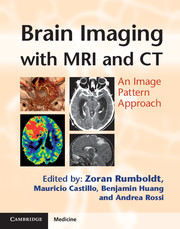Book contents
- Frontmatter
- Contents
- List of contributors
- List of abbreviations
- Preface
- Section 1 Bilateral Predominantly Symmetric Abnormalities
- Section 2 Sellar, Perisellar and Midline Lesions
- Section 3 Parenchymal Defects or Abnormal Volume
- Section 4 Abnormalities Without Significant Mass Effect
- 97 Dural Venous Sinus Thrombosis
- 98 Dural Arteriovenous Fistula
- 99 Subarachnoid Hemorrhage
- 100 Laminar Necrosis
- 101 Neurocutaneous Melanosis
- 102 Superficial Siderosis
- 103 Polymicrogyria
- 104 Seizure-Related Changes (Peri-Ictal MRI Abnormalities)
- 105 Embolic Infarcts
- 106 Focal Cortical Dysplasia
- 107 Tuberous Sclerosis Complex
- 108 Dysembroplastic Neuroepithelial Tumor (DNT, DNET)
- 109 Nonketotic Hyperglycemia With Hemichorea–Hemiballismus
- 110 Hyperdensity Following Endovascular Intervention
- 111 Early (Hyperacute) Infarct
- 112 Acute Disseminated Encephalomyelitis (ADEM)
- 113 Susac Syndrome
- 114 Diffuse Axonal Injury
- 115 Multiple Sclerosis
- 116 Progressive Multifocal Leukoencephalopathy (PML)
- 117 Nodular Heterotopia
- 118 Neurosarcoidosis
- 119 Meningeal Carcinomatosis
- 120 Meningitis (Infectious)
- 121 Perineural Tumor Spread
- 122 Moyamoya
- 123 Central Nervous System Vasculitis
- 124 Subacute Infarct
- 125 Active Multiple Sclerosis
- 126 Capillary Telangiectasia
- 127 Developmental Venous Anomaly
- 128 Immune Reconstitution Inflammatory Syndrome (IRIS)
- 129 Ventriculitis
- Section 5 Primarily Extra-Axial Focal Space-Occupying Lesions
- Section 6 Primarily Intra-Axial Masses
- Section 7 Intracranial Calcifications
- Index
- References
124 - Subacute Infarct
from Section 4 - Abnormalities Without Significant Mass Effect
Published online by Cambridge University Press: 05 August 2013
- Frontmatter
- Contents
- List of contributors
- List of abbreviations
- Preface
- Section 1 Bilateral Predominantly Symmetric Abnormalities
- Section 2 Sellar, Perisellar and Midline Lesions
- Section 3 Parenchymal Defects or Abnormal Volume
- Section 4 Abnormalities Without Significant Mass Effect
- 97 Dural Venous Sinus Thrombosis
- 98 Dural Arteriovenous Fistula
- 99 Subarachnoid Hemorrhage
- 100 Laminar Necrosis
- 101 Neurocutaneous Melanosis
- 102 Superficial Siderosis
- 103 Polymicrogyria
- 104 Seizure-Related Changes (Peri-Ictal MRI Abnormalities)
- 105 Embolic Infarcts
- 106 Focal Cortical Dysplasia
- 107 Tuberous Sclerosis Complex
- 108 Dysembroplastic Neuroepithelial Tumor (DNT, DNET)
- 109 Nonketotic Hyperglycemia With Hemichorea–Hemiballismus
- 110 Hyperdensity Following Endovascular Intervention
- 111 Early (Hyperacute) Infarct
- 112 Acute Disseminated Encephalomyelitis (ADEM)
- 113 Susac Syndrome
- 114 Diffuse Axonal Injury
- 115 Multiple Sclerosis
- 116 Progressive Multifocal Leukoencephalopathy (PML)
- 117 Nodular Heterotopia
- 118 Neurosarcoidosis
- 119 Meningeal Carcinomatosis
- 120 Meningitis (Infectious)
- 121 Perineural Tumor Spread
- 122 Moyamoya
- 123 Central Nervous System Vasculitis
- 124 Subacute Infarct
- 125 Active Multiple Sclerosis
- 126 Capillary Telangiectasia
- 127 Developmental Venous Anomaly
- 128 Immune Reconstitution Inflammatory Syndrome (IRIS)
- 129 Ventriculitis
- Section 5 Primarily Extra-Axial Focal Space-Occupying Lesions
- Section 6 Primarily Intra-Axial Masses
- Section 7 Intracranial Calcifications
- Index
- References
Summary
Specific Imaging Findings
The subacute period of ischemic infarcts lasts from 24 h to approximately 2 weeks. Infarcts become better defined as well-demarcated wedge-shaped areas of low density involving both gray and white matter. Mass effect with gyral swelling, compression of the adjacent ventricles, and possible herniations may initially increase but subsequently begin diminishing after approximately 1 week and usually resolve by 3 weeks. Hemorrhage is evident in up to 20% of ischemic infarcts. Between the second and third weeks, the infarct may become isodense, a phenomenon known as “fogging”.
On MRI, ADC values continue to decrease during the hyperacute and acute periods reaching the nadir at around 4 days, and then begin to rise, returning to baseline at 1–2 weeks. Thereafter, the diffusion becomes elevated. The T2 signal intensity increases over the first 4 days and remains relatively stable, while T1 signal decreases and becomes similar to the CSF in the chronic period due to encephalomalacia. Some infarcts develop gyriform cortical T1 hyperintensity in the late subacute period (approximately 2 weeks), which peaks at 1–2 months and may resolve several months later. Patchy gyriform contrast enhancement is common, appearing at 2–6 days and persisting for up to 5 months. Sometimes cortical enhancement may be the only finding in subacute infarcts.
Pertinent Clinical Information
Patients with malignant supratentorial infarctions (typically involving > 2/3 of the MCA territory) show progressive deterioration of consciousness within 24–48 h as a result of increasing edema, commonly causing subfalcine and uncal herniation. The predisposing factors include abnormalities of the ipsilateral circle of Willis and insufficient leptomeningeal collateral vessels. Conservative treatment includes pharmacologic strategies and hypothermia. Patients who fail to respond to conservative management may require decompressive hemicraniectomies. Hemorrhagic transformation is seen in 6% of ischemic strokes within 3 days, in 17–26% within 5–7 days, and in 43% by 4 weeks, but in most cases it remains asymptomatic. Symptomatic hemorrhagic transformation occurs in up to 6.8% of untreated patients and in up to 11% of cases following intra-arterial thombolytic treatment.
Information
- Type
- Chapter
- Information
- Brain Imaging with MRI and CTAn Image Pattern Approach, pp. 255 - 256Publisher: Cambridge University PressPrint publication year: 2012
